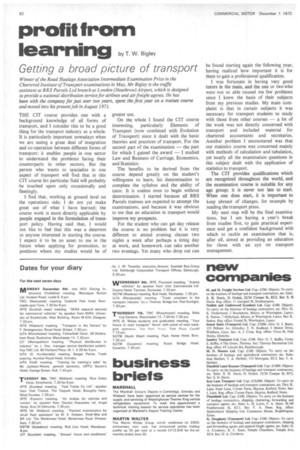profit from
Page 84

If you've noticed an error in this article please click here to report it so we can fix it.
learningby T. W Bigley
Getting a broad picture of transport
Winner of the Road Haulage Association Intermediate Examination Prize in the Chartered Institute of Transport examinations in May, Mr Bigley is the traffic assistant at BRS Parcels Ltd branch at London (Heathrow) Airport, which is designed to provide a national distribution service for airlines and air freight agents. He has been with the company for just over two years, spent the first year on a trainee course and moved into his present job in August 1971.
THE CIT course provides one with a background knowledge of all forms of transport, and I consider this to be a good thing for the transport industry as a whole. It is particularly important nowadays when we are seeing a great deal of integration and co-operation between different forms of transport: it enables people in one sector to understand the problems facing their counterparts in other sectors. But the person who wants to specialize in one aspect of transport will find that in this CIT course his particular field will probably be touched upon only occasionally and fleetingly.
I find that, working at ground level on the operations side; I do not yet make great use of what I have learned; the course work is more directly applicable by people engaged in the formulation of transport policy. Having said that, I would not like to feel that this was a deterrent to anyone interested in starting the course. I expect it to be an asset to me in the future when applying for promotion, to positions where my studies would be of greater use.
On the whole I found the CIT course interesting, particularly Elements of Transport (now combined with Evolution of Transport) since it dealt with the basic theories and practices of transport. For the second part of the examination the part for which I gained the award I studied Law and Business of Carriage, Economics, and Statistics.
The benefits to be derived from the course depend greatly on the student's willingness to learn, his determination to complete the syllabus and the ability of tutor. It is useless even to begin without determination. I started because all BRS Parcels trainees are expected to attempt the examinations, and because it was obvious to me that an education in transport would improve my prospects.
For the student who can get day release the course is no problem but it is very different to attend evening classes two nights a week after perhaps a tiring day at work, and homework can take another two evenings. Yet many who drop out can be found starting again the following year, having realized how important it is for them to gain a professional qualification.
I was fortunate in having very good tutors in the main, and the one or two who were not so able caused me few problems since I knew the basis of their subjects from my previous studies. My main complaint is that in certain subjects it was necessary for transport students to study with those from other courses a lot of the work was not directly concerned with transport and included material for chartered accountants and secretaries. Another problem I encountered was that our statistics course was concerned mainly with methods of calculation and tabulation, yet nearly all the examination questions in this subject dealt with the application of statistics to transport.
The CIT provides qualifications which are recognized throughout the world, and the examination course is suitable for any age group; it is never too late to start. When one does start, it is important to keep abreast of changes, for example by reading the transport press.
My next step will be the final examinations, but I am having a year's break from studies first, to gain practical experience and get a confident background with which to tackle an examination that is, after all, aimed at providing an education for those with an eye on transport management.
































































































































